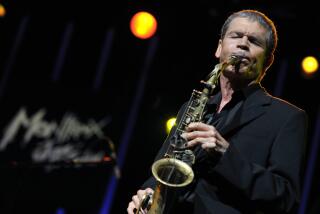On the Move
- Share via
One of the more compelling and risk-taking saxophonists around, Greg Osby, at 37 is in artistic mid-stride. He has honed a crisp, thoughtful playing style on the alto sax, and helped lay the groundwork for the adventurous M-BASE movement in the ‘80s, one of the few progressive and worthwhile subgenres in jazz in the past two decades.
Osby has also won favor with the jazz press. Still, after all the years and accolades, Osby is a musician deserving of greater recognition.
In support of his new album, Osby has taken his band west, including a stop at the Jazz Hall in Santa Barbara on Sunday, but not for love of money.
“I’m out here barnstorming, doing my grass-roots tour of the United States,” Osby said from a stop in San Francisco last week. “There’s no money to be made in the United States, unless you’re part of the A-list.”
Ironically, Osby’s greatest claim to media fame outside of jazz circles may have come a few years ago when he briefly flirted with the marriage of jazz and hip-hop.
“It ran its course, as far as I’m concerned,” Osby said. “I lived in the middle of Brooklyn and there was no way to avoid hip-hop . . . I wanted to see what would happen if I juxtaposed that with the science behind what I was doing . . . It was an experiment.
“The people I admire in music took it somewhere else because they straddled the fence. John Coltrane experimented with Indian music and Western African music. Miles Davis was experimenting with modes, electronic music and fusion. Charlie Parker experimented with big band music and Afro-Cuban music. That’s how they got another sound.”
As heard on “Further Ado,” Osby’s often-tricky material veers from traditional jazz vocabulary to aspects of avant-garde and even groove music. His current band is made up of young players, including the dynamic pianist Jason Moran, a standout on the album.
Osby came up through time-honored jazz channels, but ended up carving out his alternate musical route. After growing up in St. Louis, he wound up at Howard University. After a stint at the Berklee School in Boston, he was hired by Jon Faddis and Dizzy Gillespie.
But even as Osby was getting noticed as a player in conventional jazz circles in the early ‘80s, he was working on a new conceptual order.
“I had been working on a concept, a plan, which I now call ‘shifting melodic order.’ But then I was working on it in the closet. When you’re working with something that’s untested, you’re groping for a long time, and it can sound really horrible. And it did.
“There was a pivotal gig that I did here in San Francisco, at the Great American Music Hall in 1983. Dizzy Gillespie and Ron Carter were the special guests with Jon Faddis’ group. In the dressing room, Dizzy was saying ‘Yeah, I hear what you’re trying to do. You really owe it to yourself to go for it. . . . But I have just one thing to tell you: You’re going to pay for that.’ He didn’t say anything else. He just left it for me to figure out.”
Not long after, Osby began brainstorming with Coleman, creating what became M-BASE, mixing elements of polytonality, world music and a new kind of funk-based jazz, but with the repetitive, backbeat-driven rhythm removed.
These days, Osby is carving out a healthy path between radical ideas and mature, solid musicality. In addition to leading his own band, Osby has been working selectively as a sideman, having just returned from Europe with pianist (and Ventura native) Joanne Brackeen, and working with pianist Andrew Hill and guitarist Jim Hall, on whose new live album Osby is a special guest.
“I feel confident that I can bounce into any [situation] and . . . not have to make any concessions,” he said. “I don’t have to water it down or alter anything. I can still be my own voice. It took me awhile to feel that way.”
BE THERE
Greg Osby, Sunday, 8:30 and 10:30 p.m. at Jazz Hall, 28 E. Victoria St. in Santa Barbara. $15; 963-0404.
More to Read
The biggest entertainment stories
Get our big stories about Hollywood, film, television, music, arts, culture and more right in your inbox as soon as they publish.
You may occasionally receive promotional content from the Los Angeles Times.










